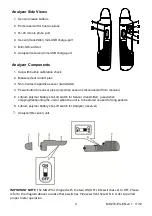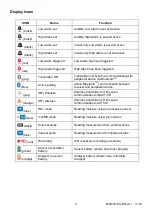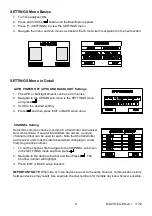
MO270-EU-EN-v2.1 11/12
14
Calibration Verification
Calibration Zero Check for Pinless Mode
1. Switch the analyzer to the Pinless mode of operation (REL mode) from the
F1-MENU
. The box
at the upper left will either be labeled WME or REL. Use the ENTER button to toggle WME and
REL modes.
2. Switch the meter OFF.
3. Ensure that the analyzer is not near any objects or surfaces. Hold the analyzer near the bottom
to avoid contact with the pinless sensor.
4. Switch the meter ON.
5. The display should read zero.
6. If an error is displayed or if the analyzer reads other than zero, please return the unit for
service.
Calibration Check for Pin Mode
1. Switch the analyzer to the Pin mode (WME) from the
F1-MENU
. Use the ENTER key to toggle
REL and WME.
2. The three calibration check points are located in the holes at the top of the protective cap.
3. The first measurement is made by connecting to the two test points label
ed ‘L’ (for LOW) with
the meter’s pins. The second measurement is made by connecting to the two test points
labeled ‘H’ (for HIGH).
4. The display should read between 60.0 to 85.0 for the high measurement and between 17.0
and 19.0 for the low measurement.
5. If the readings are not correct, return the analyzer for service.
FCC Compliance
FCC-ID: IWK-EX3000
FCC-ID: IWK-MO270X
This device complies with part 15 of the FCC Rules. Operation is subject to the following two conditions:
1. This device may not cause harmful interference.
2. This device must accept any interference received, including interference that may cause undesired
operation.
This equipment has been tested and found to comply with the limits for a Class B digital device, pursuant to part
15 of the FCC Rules. These limits are designed to provide reasonable protection against harmful interference in a
residential installation. This equipment generates, uses, and can radiate radio frequency energy and, if not
installed and used in accordance with the instructions, may cause harmful interference to radio communications.
However, there is no guarantee that interference will not occur in a particular installation. If this equipment does
cause harmful interference to radio or television reception, which can be determined by turning the equipment off
and on, the user is encouraged to try to correct the interference by one or more of the following measures:
Reorient or relocate the receiving antenna.
Increase the separation between the equipment and receiver.
Connect the equipment into an outlet on a circuit different from that to which the receiver is connected.
Consult the dealer or an experienced radio/TV technician for help.
Warning:
Changes or modifications not expressly approved by the party responsible for compliance could void the
user's authority to operate the equipment.







































